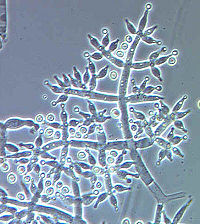
Photo from wikipedia
Native strains of Trichoderma in vineyard soil represent an opportunity for reducing the incidence of grapevine trunk diseases (GTDs) in vineyards. Moreover, its relationship with the environment (physicochemical soil characteristics… Click to show full abstract
Native strains of Trichoderma in vineyard soil represent an opportunity for reducing the incidence of grapevine trunk diseases (GTDs) in vineyards. Moreover, its relationship with the environment (physicochemical soil characteristics and farming management practices) remains unclear. In the current study, a survey was carried out on farming management used by viticulturists, and soil samples were studied to analyze their physicochemical properties and to isolate Trichoderma strains. Later, statistical analyses were performed to identify possible correlations between Trichoderma populations, soil management and soil characteristics. In addition, in vitro tests, including antibiosis and mycoparasitism, were performed to select those Trichoderma strains able to antagonize Phaeoacremonium minimum. In this study a positive correlation was found between the iron content and pH in the soil, and a lower pH increases Trichoderma populations in soils. Vineyard management also affects Trichoderma populations in the soil, negatively in the case of fertilization and tillage and positively in the case of herbicide spraying. Two Trichoderma native strains were selected as potential biocontrol agents (Trichoderma gamsii T065 and Trichoderma harzianum T087) using antibiosis and mycoparasitism as mechanisms of action. These results led to the conclusion that native Trichoderma strains hold great potential as biological control agents and as producers of secondary metabolites.
Journal Title: Plants
Year Published: 2023
Link to full text (if available)
Share on Social Media: Sign Up to like & get
recommendations!